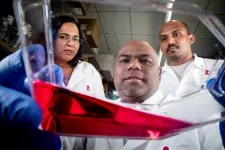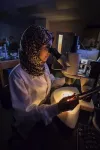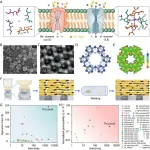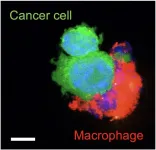(Press-News.org) (MEMPHIS, Tenn. – June 14, 2024) The innate immune system is responsible for protecting the human body from threats that could cause disease or infection. The system relies on innate immune sensors to detect and transmit signals about these threats. One of the key innate immune strategies to respond to threats is through cell death. New research from St. Jude Children’s Research Hospital discovered that NLRC5 plays a previously unknown role as an innate immune sensor, triggering cell death. The findings, published in Cell, show how NLRC5 drives PANoptosis, a prominent type of inflammatory cell death. This understanding has implications for the development of therapeutics that target NLRC5 for the treatment of infections, inflammatory diseases and aging.
Depending on the threat, innate immune sensors can assemble complexes such as inflammasomes or PANoptosomes. The inflammasome can be thought of like an emergency broadcast system that is activated quickly, while the PANoptosome is more like an emergency response unit that generally integrates more signals and components to respond to the threat. How innate immune sensors work – what triggers them to act – has been a mystery, which researchers have been chipping away at for decades.
Nucleotide-binding oligomerization domain-like receptors (NLRs) are a large family of important molecules involved in inflammatory signaling. They are generally thought to function as innate immune sensors that detect threats. However, the specific roles of several NLRs in sensing are not yet understood. Scientists at St. Jude conducted a large screen, testing a specific NLR, NLRC5, to see what threats activate it. Through their efforts, they discovered that depletion of nicotinamide adenine dinucleotide (NAD), a molecule essential in energy production, triggers NLRC5-mediated cell death through PANoptosis.
“One of the biggest questions in the fields of immunology and innate immunity is what the various members of the NLR family are sensing, and what their functions are,” said corresponding author Thirumala-Devi Kanneganti, PhD, St. Jude Department of Immunology vice chair. “NLRC5 was an enigmatic molecule, but now we have the answer – it is acting as an innate immune sensor and cell death regulator, driving inflammatory cell death, PANoptosis, by forming a complex.”
Identifying the NLRC5 trigger
Scientists in the Kanneganti lab conducted a rigorous screen to get to the bottom of what threats trigger NLRC5. This included looking at pathogens such as bacteria and viruses, as well as pathogen associated molecular patterns (PAMPs) and damage associated molecular patterns (DAMPs) that can be released by or mimic an infection or the cause of an injury or illness, as well as other danger signals such as cytokines (immune signaling molecules).
The researchers also looked at heme, the component of hemoglobin responsible for carrying oxygen. Infections or disease can cause red blood cells to rupture in a process called hemolysis. This releases hemoglobin into the bloodstream. When hemoglobin breaks down into its components, it releases free heme, which is known to cause significant inflammation and organ damage. The researchers tested many different combinations of pathogens, PAMPs and DAMPs to see if NLRC5 was required for a response.
“Among all the combinations we tested, we identified that the combination of heme plus PAMPs or cytokines specifically induces NLRC5-dependent inflammatory cell death, PANoptosis,” said co-first author Balamurugan Sundaram, PhD, St. Jude Department of Immunology. “Our results showed for the first time that NLRC5 is central to responses to hemolysis, which can occur during infections, inflammatory diseases and cancers.”
Energy depletion triggers NLRC5 function
Upon identifying the heme-containing PAMP, DAMP and cytokine combinations that trigger NLRC5-dependent inflammatory cell death, the researchers further investigated how NLRC5 is regulated. They found that NAD levels drive NLRC5 protein expression. If NAD is depleted, that sounds an alarm that there is a threat the immune system should recognize. The researchers found that depletion of NAD is sensed by NLRC5, triggering PANoptosis.
“By supplementing with the NAD precursor, nicotinamide, we reduced NLRC5 protein expression and PANoptosis,” said co-first author Nagakannan Pandian, PhD, St. Jude Department of Immunology. “Therapeutically, nicotinamide has been widely studied as a nutrient supplement, and our findings suggest it could be helpful in treating inflammatory diseases.”
The researchers also discovered that NLRC5 is in an NLR network with NLRP12, which come together with other cell death molecules and form an NLRC5-PANoptosome complex that triggers inflammatory cell death. The finding builds on previous research by the Kanneganti lab showcasing the role of NLRP12 in PANoptosis.
A promising target for therapeutic development
NLRs are associated with diseases related to infection, inflammation, cancers and aging. This makes them intriguing targets for the development of novel therapeutics. The work of the Kanneganti lab shows that deleting Nlrc5 can provide protection against inflammatory cell death through PANoptosis and prevent disease pathology in hemolytic and inflammatory disease models, making NLRC5 an exciting therapeutic prospect.
“The fundamental knowledge that we have gained into how innate immune sensing works can be translated to numerous diseases and conditions,” Kanneganti said. “Aging, infectious disease, inflammatory disorders – things for which there are no targeted therapies, this could be an option.”
Authors and funding
The study’s other authors are Emily Alonzo, Department of Research and Development at Cell Signaling Technology; and Hee Jin Kim, Hadia Abdelaal, Omkar Indari, Roman Sarkar, Rebecca Tweedell, Jonathan Klein, Shondra Pruett-Miller and Peter Vogel, all of St. Jude, and Raghvendra Mall, formerly of St. Jude now of the Technology Innovation Institute, Abu Dhabi.
The study was supported by grants from the National Institutes of Health (AI101935, AI124346, AI160179, AR056296 and CA253095) and ALSAC, the fundraising and awareness organization of St. Jude.
St. Jude Media Relations Contacts
Michael Sheffield
Desk: (901) 595-0221
michael.sheffield@stjude.org
media@stjude.org
Rae Lyn Hartley
Cell: (901) 686-2597
raelyn.rushing@stjude.org
media@stjude.org
St. Jude Children's Research Hospital
St. Jude Children's Research Hospital is leading the way the world understands, treats and cures childhood cancer, sickle cell disease and other life-threatening disorders. It is the only National Cancer Institute-designated Comprehensive Cancer Center devoted solely to children. Treatments developed at St. Jude have helped push the overall childhood cancer survival rate from 20% to 80% since the hospital opened more than 60 years ago. St. Jude shares the breakthroughs it makes to help doctors and researchers at local hospitals and cancer centers around the world improve the quality of treatment and care for even more children. To learn more, visit stjude.org, read St. Jude Progress, a digital magazine, and follow St. Jude on social media at @stjuderesearch.
END
St. Jude scientists solve decades long mystery of NLRC5 sensor function in cell death
St. Jude Children’s Research Hospital announces a study identifying NLRC5 as an innate immune sensor playing a crucial role in PANoptotic cell death – making it a key therapeutic target
2024-06-14
ELSE PRESS RELEASES FROM THIS DATE:
Gonadal function in male mice disrupted by prenatal risk factors
2024-06-14
Researchers have consistently shown that prenatal exposure to Di (2-ethyhexyl) phthalate harms the reproductive system in male mice and causes fertility defects. In a new study, scientists from the University of Illinois Urbana-Champaign have shown that the combination of DEHP and a high-fat diet in pregnant mice can cause more damage to pups than each factor alone.
Male reproductive disorders are a growing issue due to the global decrease in sperm count and quality. Concerningly, chemicals like DEHP, which can be found in food storage containers, pharmaceuticals, and building materials, have been ...
Endangered sea cucumbers for sale in NYC food markets
2024-06-14
ITHACA, N.Y. - After surveying food market retailers in three New York City Chinatown districts, Cornell University researchers have found genetic evidence that some endangered species of sea cucumbers – considered a pricey but nutritious dried delicacy – are being sold to consumers.
The researchers collected 103 samples of dried sea cucumbers from retail food shops. By using mitochondrial DNA testing, they successfully identified 74 examples of sea cucumbers. Eight were classified as brown sea cucumbers– which are threatened and found on the International Union for the Conservation of Nature (IUCN) Red List due to overharvesting.
“We ...
Infectious H5N1 influenza virus in raw milk rapidly declines with heat treatment
2024-06-14
WHAT:
The amount of infectious H5N1 influenza viruses in raw milk rapidly declined with heat treatment in laboratory research conducted by scientists at the National Institute of Allergy and Infectious Diseases (NIAID), part of the National Institutes of Health. However, small, detectable amounts of infectious virus remained in raw milk samples with high virus levels when treated at 72 degrees Celsius (161.6 degrees Fahrenheit) for 15 seconds—one of the standard pasteurization methods used by the dairy industry. The authors of the study stress, ...
Erk5 and its potential applications in cancer treatment
2024-06-14
“Elucidating the function of Erk5 in cancer [...] will contribute to a better understanding of cancer pathogenesis and the development of novel therapeutic strategies.”
BUFFALO, NY- June 14, 2024 – A new editorial paper was published in Oncoscience (Volume 11) on May 20, 2024, entitled, “Role of Erk5 expressed in bone marrow mesenchymal stem cells on bone homeostasis and its potential applications in cancer treatment.”
In their new editorial, researchers Tetsuhiro Horie and Eiichi Hinoi from Kanazawa ...
Novel insights into fluorescent ‘dark states’ illuminate ways forward for improved imaging
2024-06-14
(MEMPHIS, Tenn. – June 14, 2024) Scientists at St. Jude Children’s Research Hospital today announced a way to improve molecular scale distance measurements using single-molecule fluorescence resonance energy transfer (smFRET). smFRET quantifies the excitation and emission properties of chemicals called fluorophores.
When an excited electron in the fluorophore relaxes, it emits light after a delay, causing the molecule to glow (fluoresce). However, fluorophores don’t always fluoresce after excitation. Instead, through quantum mechanical ...
UT Health San Antonio School of Dentistry to launch new Center for Regenerative Sciences
2024-06-14
SAN ANTONIO, June 14, 2024 – The University of Texas Health Science Center at San Antonio School of Dentistry is preparing to launch its Center for Regenerative Sciences, a new research initiative that aims to position the university at the forefront of regenerative dentistry and medicine.
“The center will provide new avenues for interdisciplinary collaborations to accelerate the translation of preclinical discoveries into therapeutic benefit for patients suffering from dental, oral and craniofacial diseases,” said Yong-Hee Chun, DDS, PhD, MS, associate professor of ...
New carbon nitride membrane revolutionizes lithium extraction from salt lakes
2024-06-14
In a major breakthrough for lithium recovery technologies, researchers from the Qingdao Institute of Bioenergy and Bioprocess Technology (QIBEBT) of the Chinese Academy of Sciences, together with collaborators, have developed a crystalline carbon nitride membrane that could transform the lithium extraction industry.
The innovative design, which mimics biological ion channels, shows remarkable efficiency and durability in separating lithium ions from magnesium ions in salt-lake brine.
The study, published in Science Advances on June 14, introduces a ...
Nano-immunotherapy developed to improve lung cancer treatment
2024-06-14
KEY TAKEAWAYS
Lung cancer is the most diagnosed cancer and the leading cause of cancer death globally, representing an urgent need for new and improved treatment options.
Researchers from Brigham and Women’s Hospital developed a new nanomedicine therapy that delivers anticancer drugs to lung cancer cells and enhances the immune system's ability to fight cancer.
The research must undergo rigorous toxicology studies before moving into clinical testing in patients but represents a potential treatment for patients who have failed to respond to traditional immunotherapy.
Researchers at Brigham and ...
Upper surface of coastal waters can accumulate bacteria and antibiotics
2024-06-14
Atlanta, GA – June 14, 2024 – Antibiotics in the uppermost water surface, known as the sea surface microlayer, can significantly affect the number of bacteria present and contribute to the adaptation of marine bacteria against widely used antibiotics. In new research presented at ASM Microbe, scientists directly assessed the potential effects of antibiotics on bacterial diversity in Jade Bay, Southern North Sea, Germany.
The researchers tested the susceptibility and resistance of marine bacteria to ofloxacin, ...
AI enables faster, more effective antibiotic treatment of sepsis
2024-06-14
Atlanta, GA—Sepsis is a life-threatening infection complication and accounts for 1.7 million hospitalizations and 350,000 deaths annually in the U.S. Fast and accurate diagnosis is critical, as mortality risk increases up to 8% every hour without effective treatment. However, the current diagnostic standard is reliant on culture growth, which typically takes 2-3 days. Doctors may choose to administer broad-spectrum antibiotics until more information is available for an accurate diagnosis, but these can have limited efficacy and potential toxicity to the patient.
In a study presented at ASM Microbe, a team from Day Zero Diagnostics unveiled a novel approach to antimicrobial susceptibility ...
LAST 30 PRESS RELEASES:
Interaction of climate change and human activity and its impact on plant diversity in Qinghai-Tibet plateau
From addressing uncertainty to national strategy: an interpretation of Professor Lim Siong Guan’s views
Clinical trials on AI language model use in digestive healthcare
Scientists improve robotic visual–inertial trajectory localization accuracy using cross-modal interaction and selection techniques
Correlation between cancer cachexia and immune-related adverse events in HCC
Human adipose tissue: a new source for functional organoids
Metro lines double as freight highways during off-peak hours, Beijing study shows
Biomedical functions and applications of nanomaterials in tumor diagnosis and treatment: perspectives from ophthalmic oncology
3D imaging unveils how passivation improves perovskite solar cell performance
Enriching framework Al sites in 8-membered rings of Cu-SSZ-39 zeolite to enhance low-temperature ammonia selective catalytic reduction performance
AI-powered RNA drug development: a new frontier in therapeutics
Decoupling the HOR enhancement on PtRu: Dynamically matching interfacial water to reaction coordinates
Sulfur isn’t poisonous when it synergistically acts with phosphine in olefins hydroformylation
URI researchers uncover molecular mechanisms behind speciation in corals
Chitin based carbon aerogel offers a cleaner way to store thermal energy
Tracing hidden sources of nitrate pollution in rapidly changing rural urban landscapes
Viruses on plastic pollution may quietly accelerate the spread of antibiotic resistance
Three UH Rainbow Babies & Children’s faculty elected to prestigious American Pediatric Society
Tunnel resilience models unveiled to aid post-earthquake recovery
Satellite communication systems: the future of 5G/6G connectivity
Space computing power networks: a new frontier for satellite technologies
Experiments advance potential of protein that makes hydrogen sulfide as a therapeutic target for Alzheimer’s disease
Examining private equity’s role in fertility care
Current Molecular Pharmacology achieves a landmark: real-time CiteScore advances to 7.2
Skeletal muscle epigenetic clocks developed using postmortem tissue from an Asian population
Estimating unemployment rates with social media data
Climate policies can backfire by eroding “green” values, study finds
Too much screen time too soon? A*STAR study links infant screen exposure to brain changes and teen anxiety
Global psychiatry mourns Professor Dan Stein, visionary who transformed mental health science across Africa and beyond
KIST develops eco-friendly palladium recovery technology to safeguard resource security
[Press-News.org] St. Jude scientists solve decades long mystery of NLRC5 sensor function in cell deathSt. Jude Children’s Research Hospital announces a study identifying NLRC5 as an innate immune sensor playing a crucial role in PANoptotic cell death – making it a key therapeutic target








